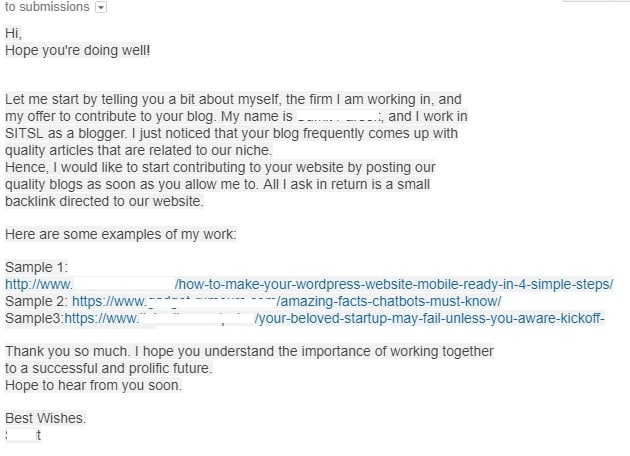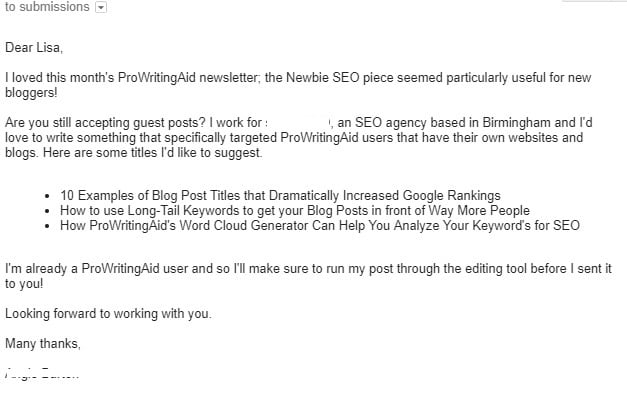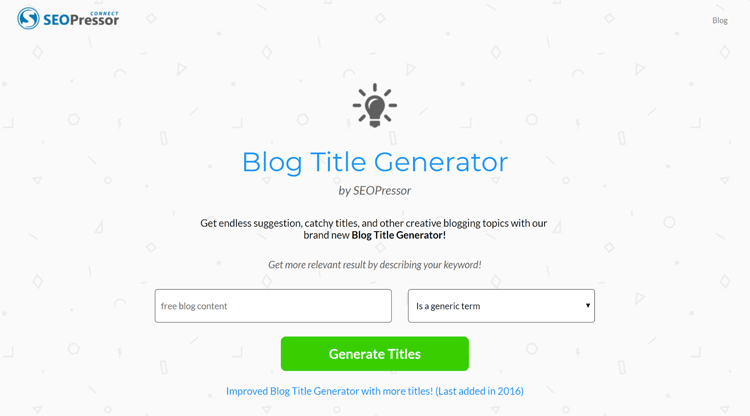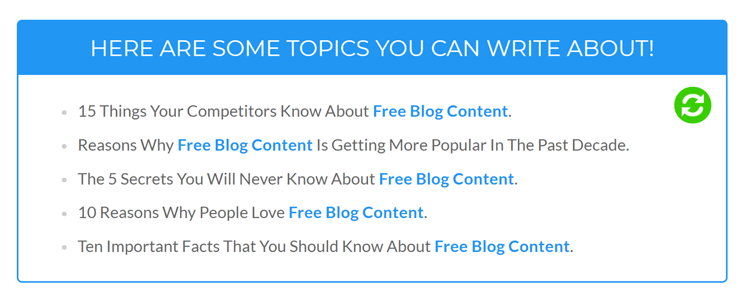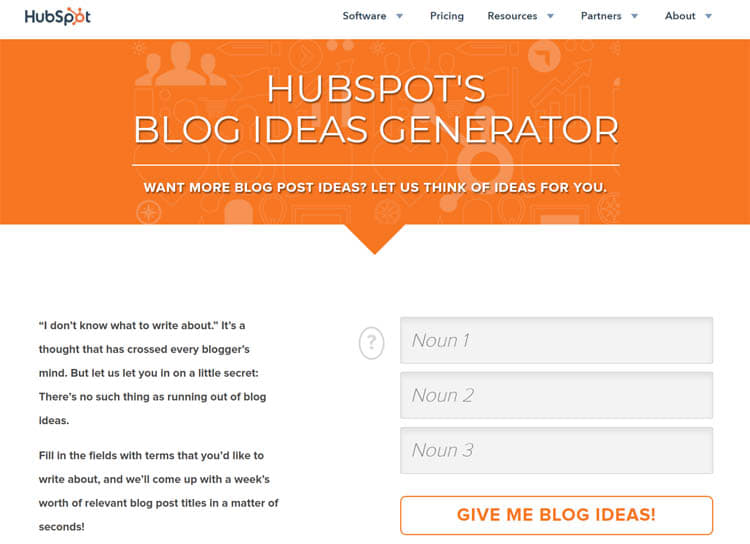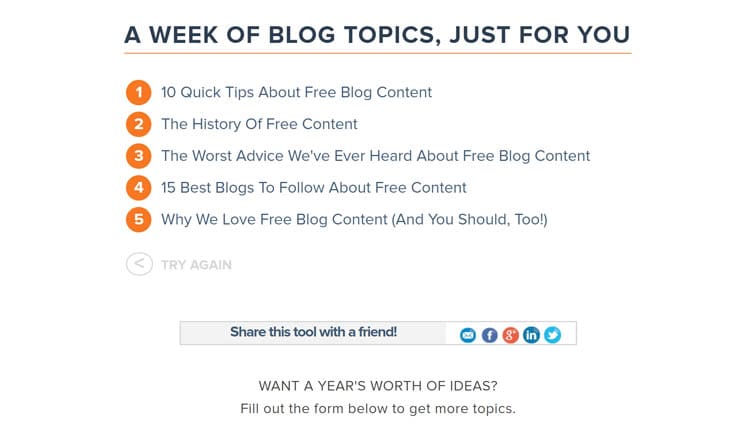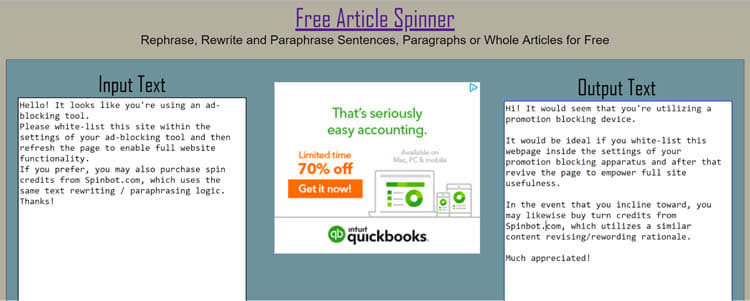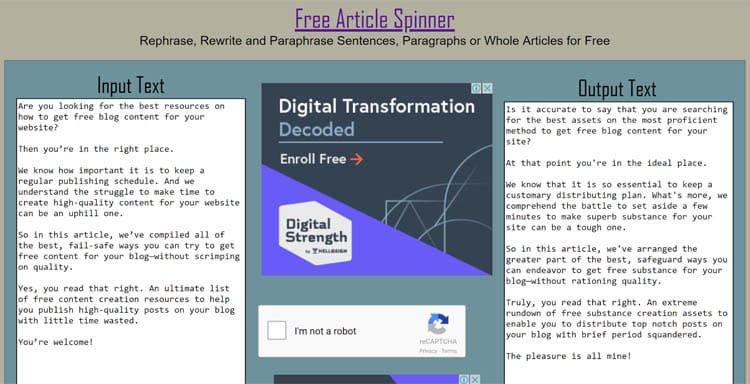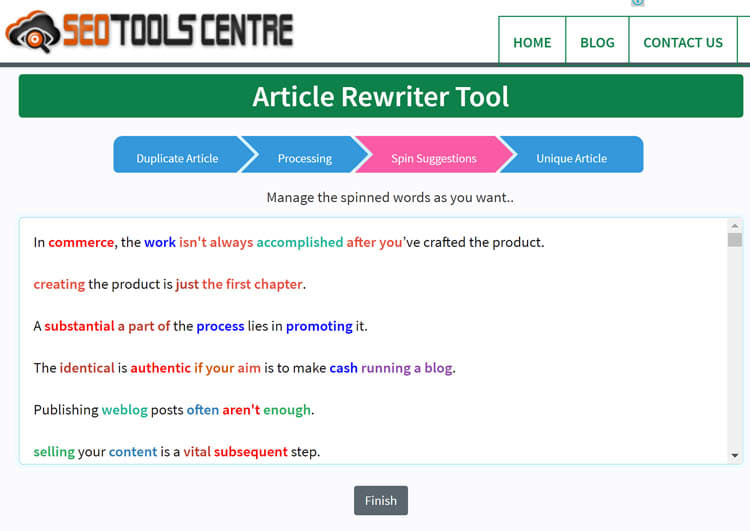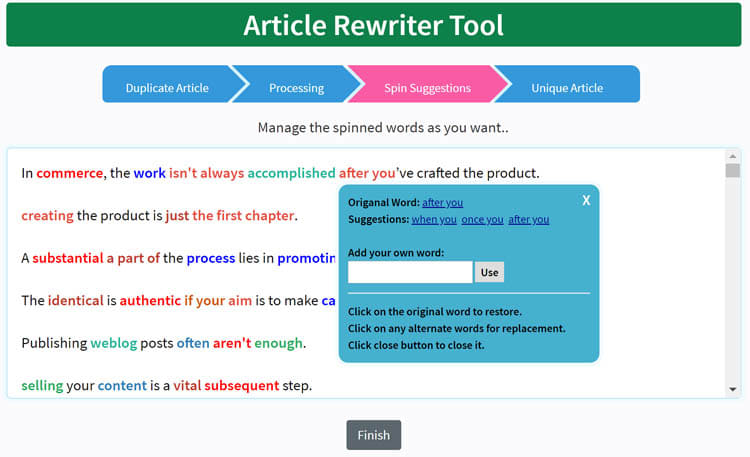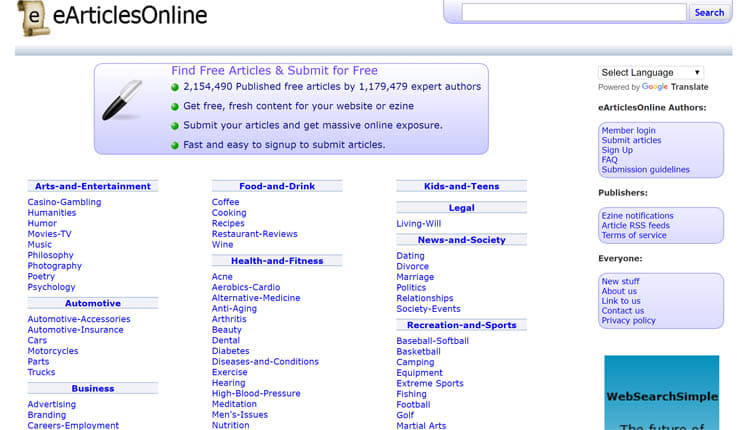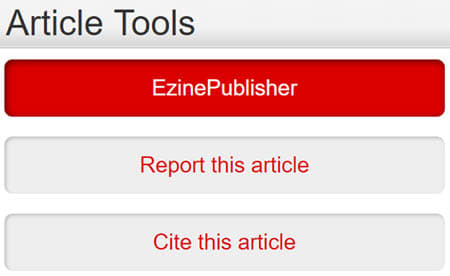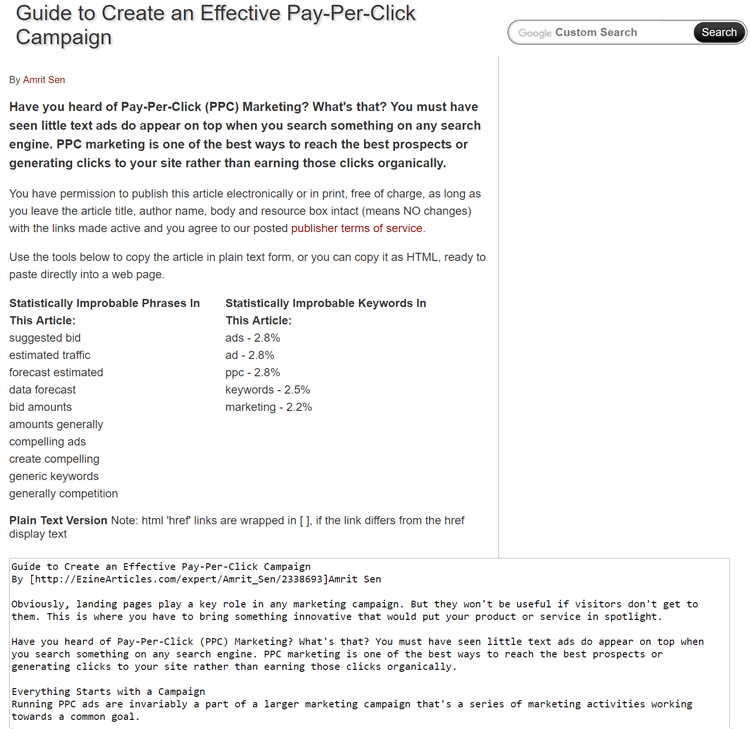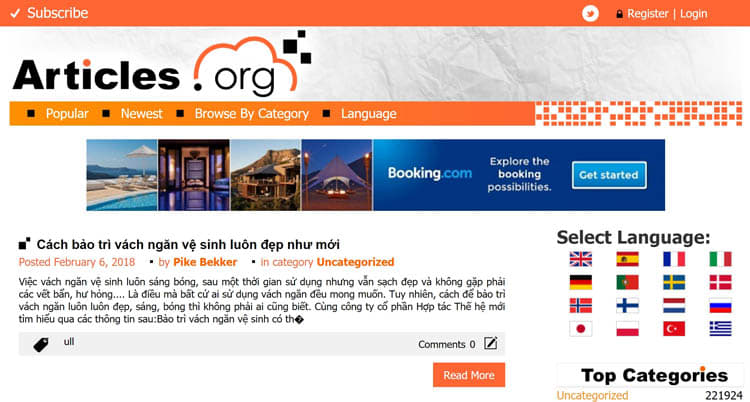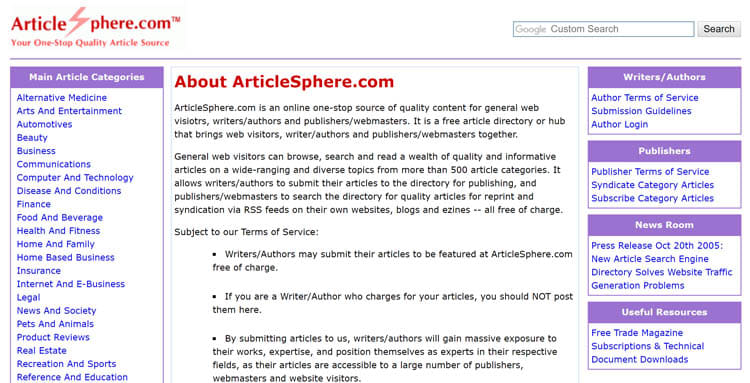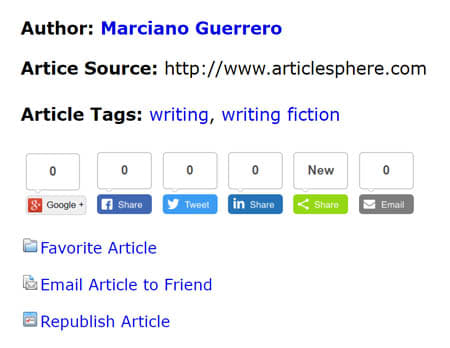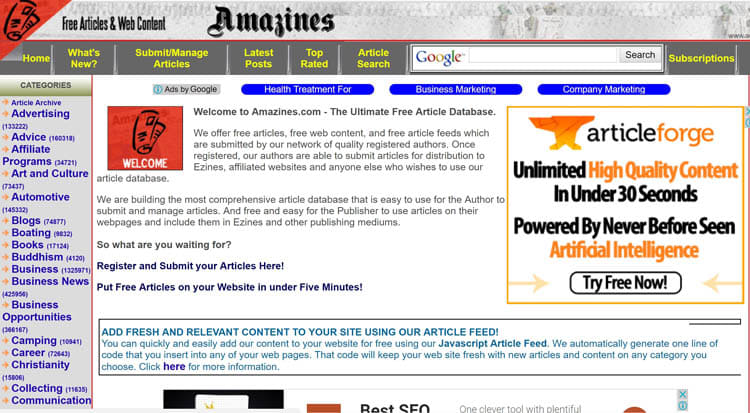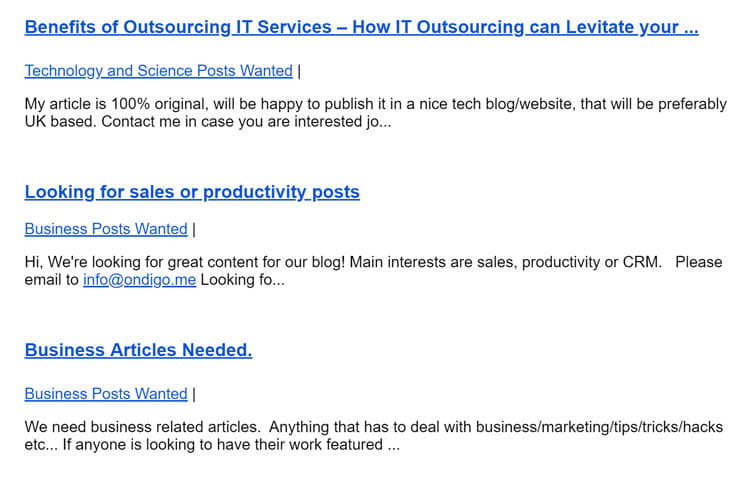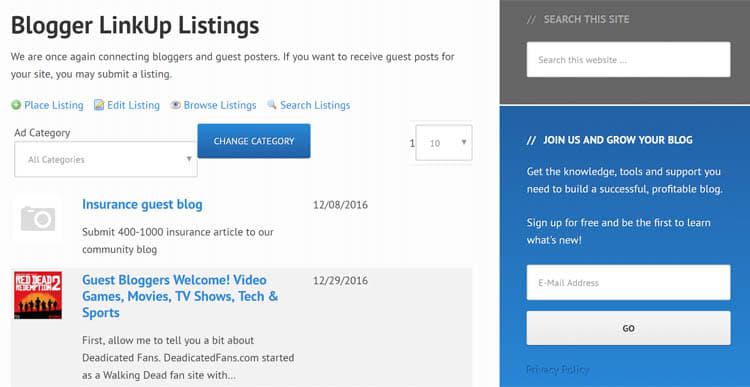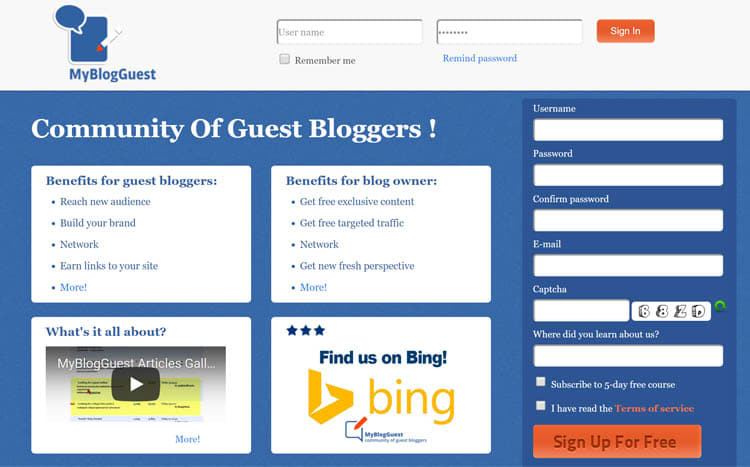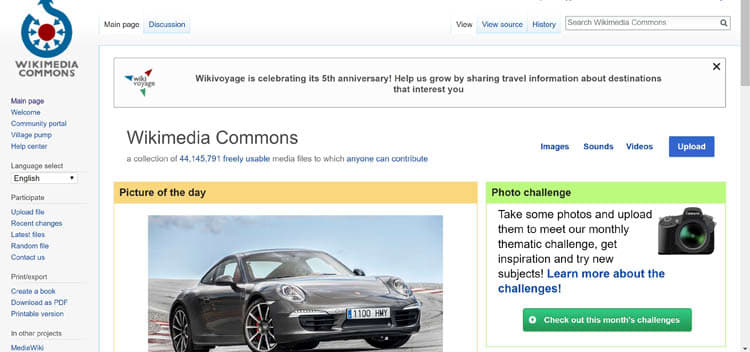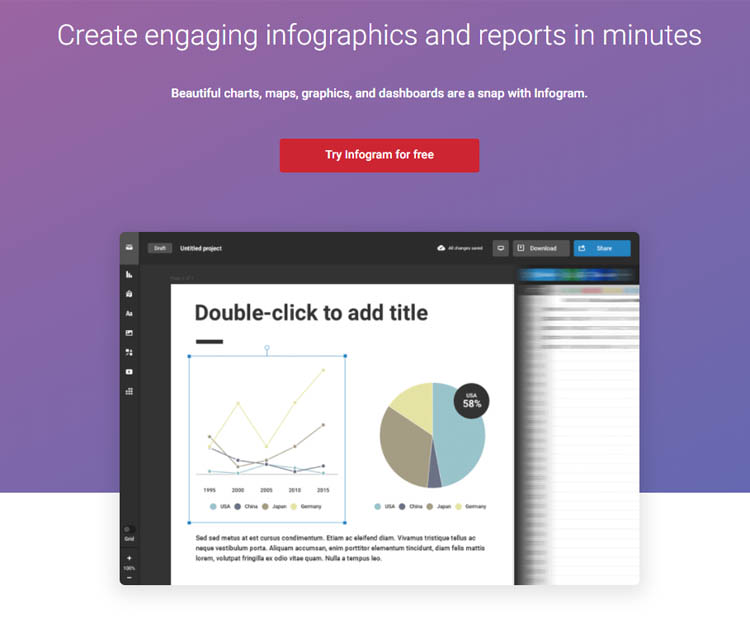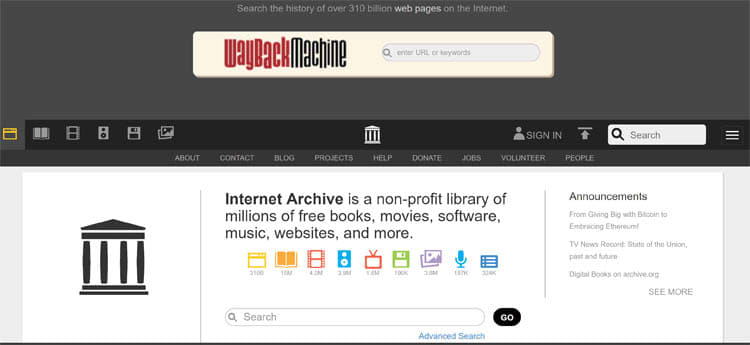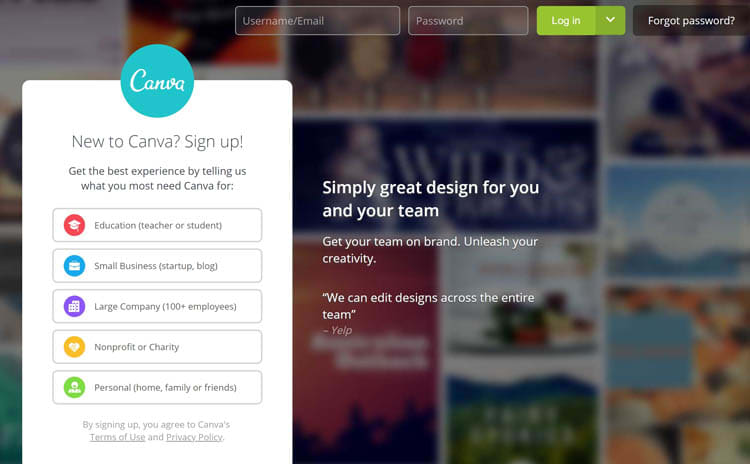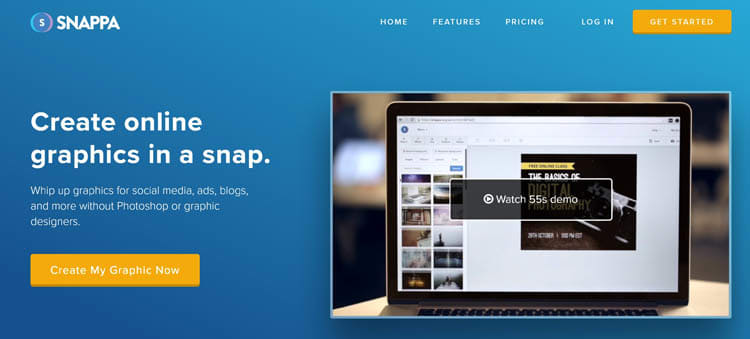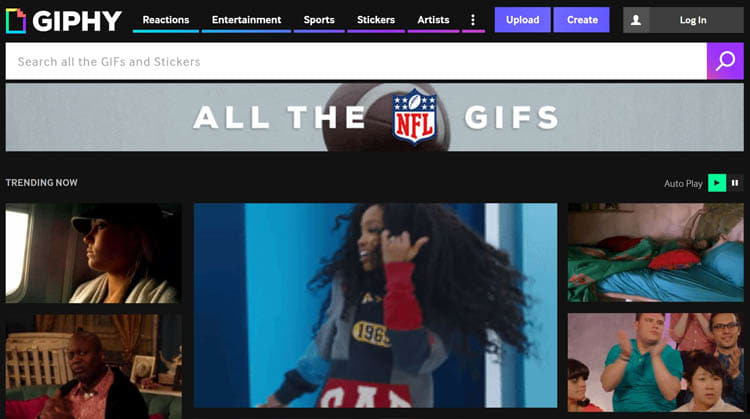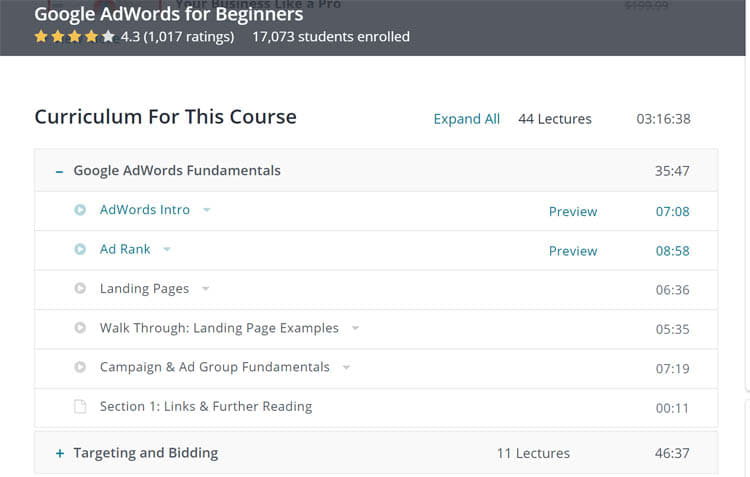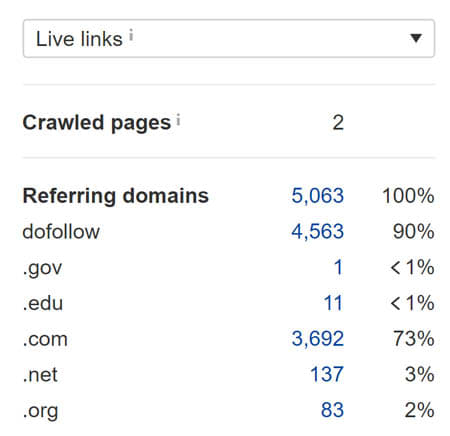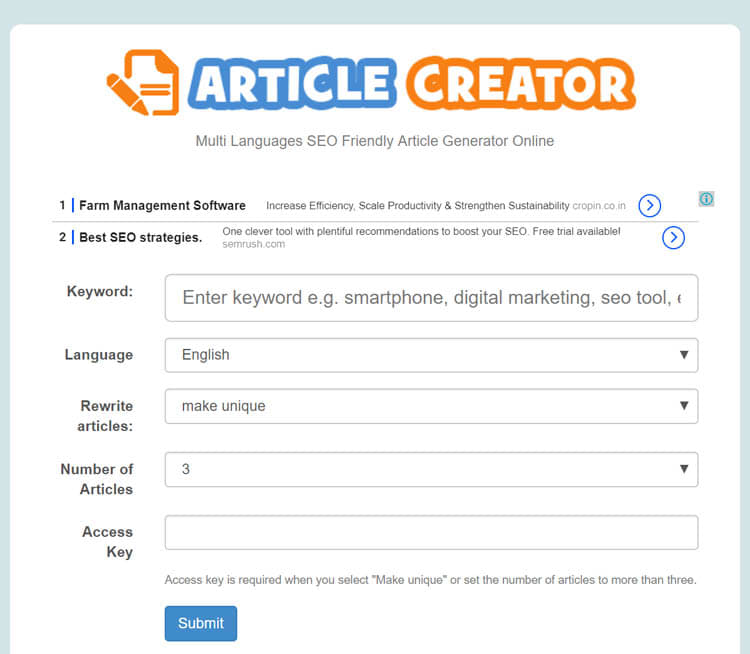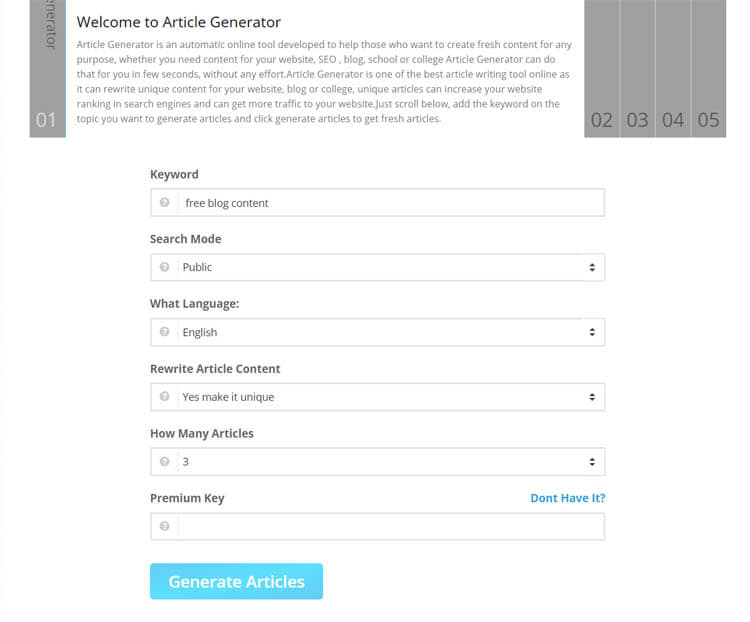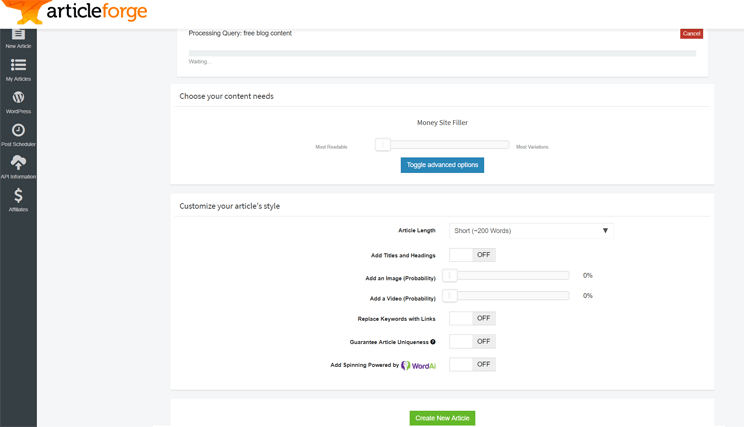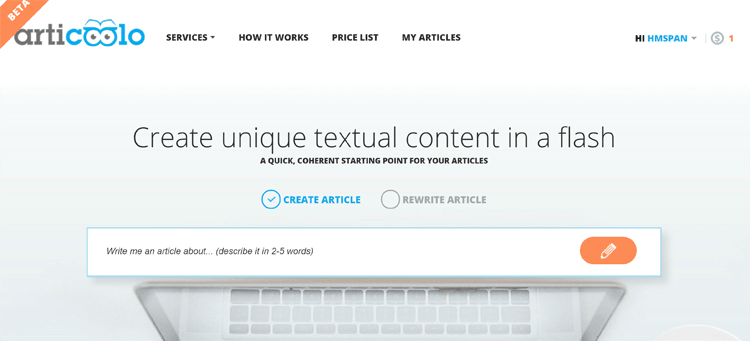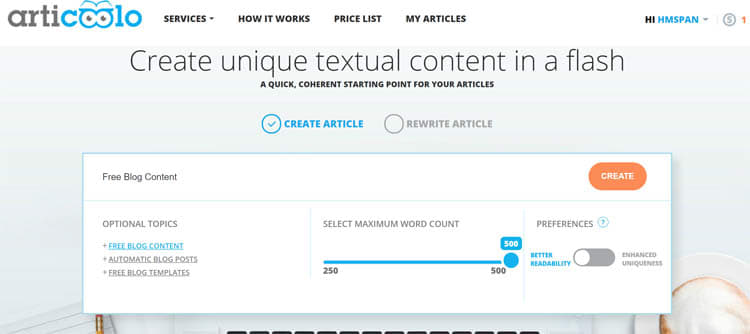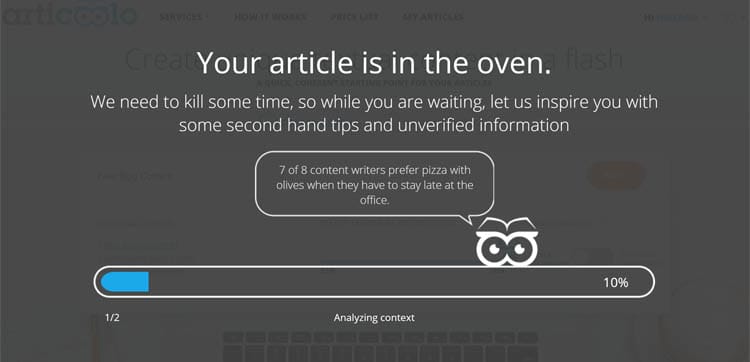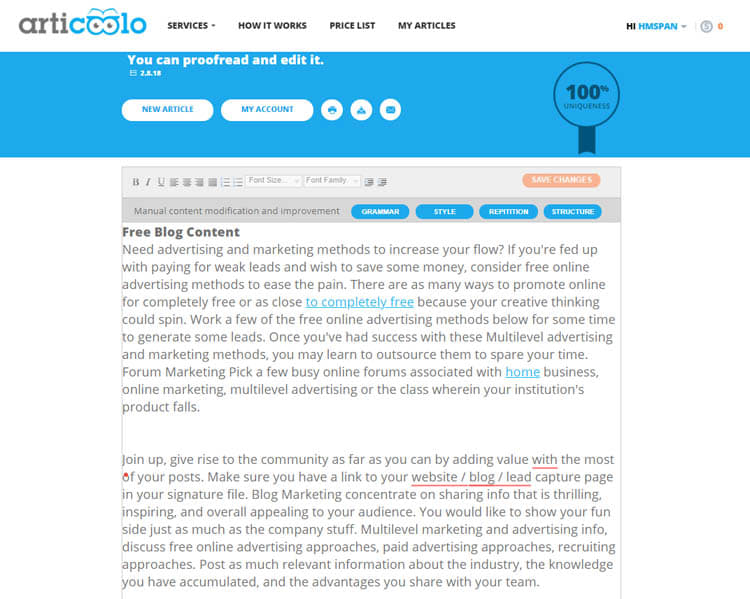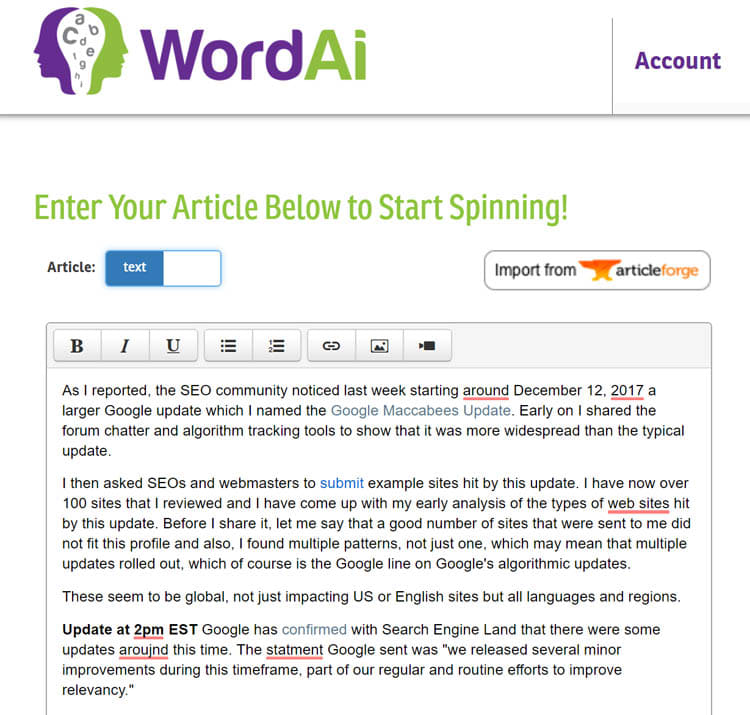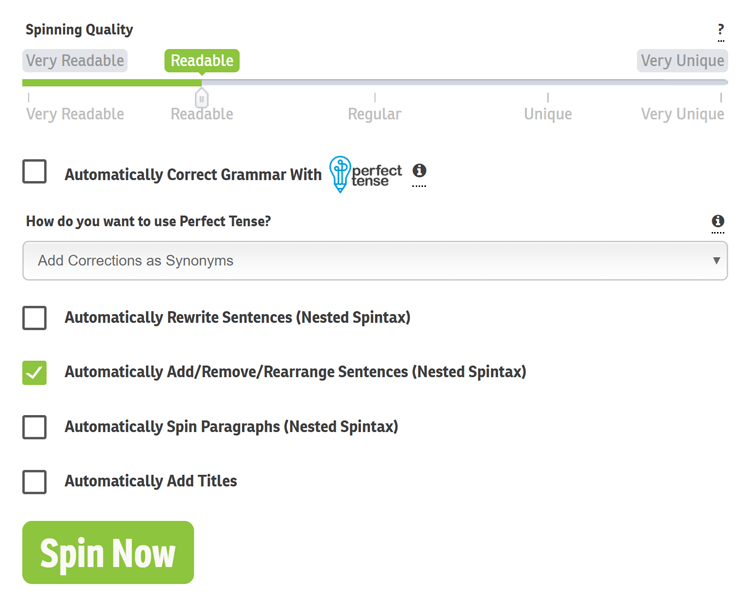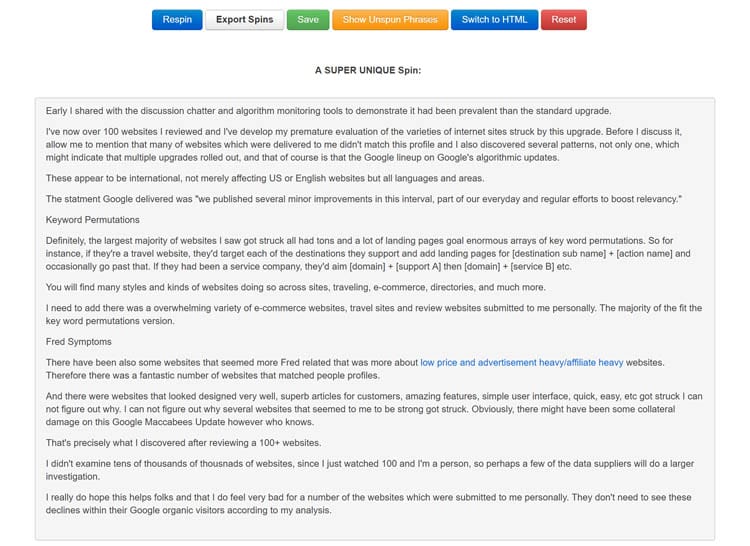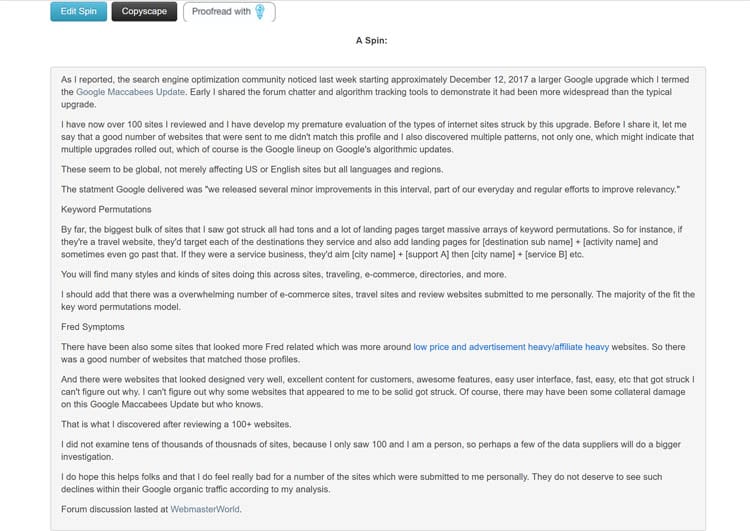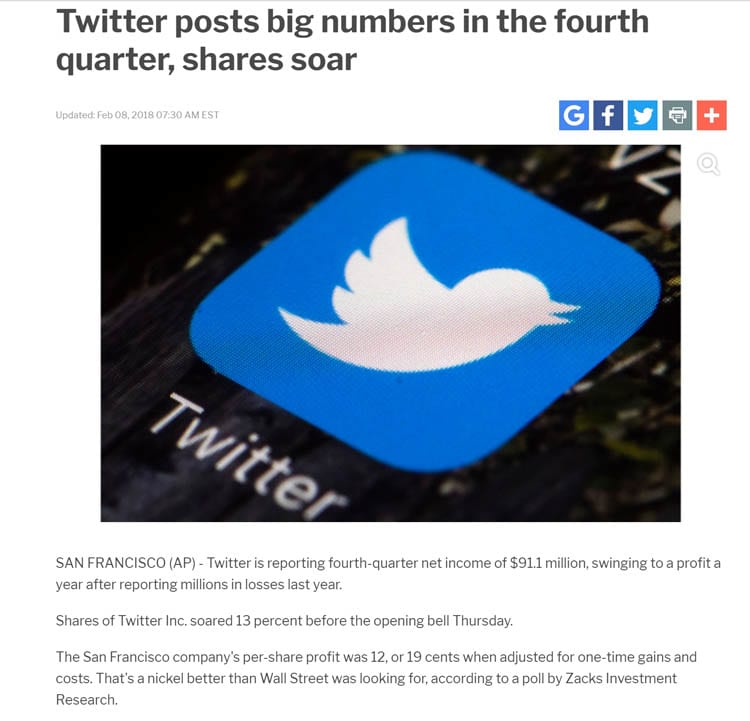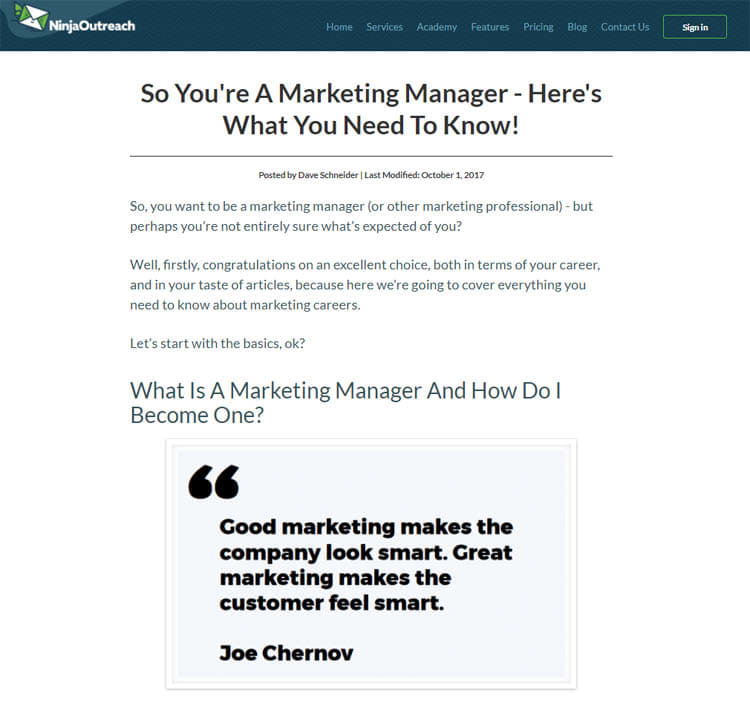Tuesday, 27 February 2018
Bad Template: How Not to Sabotage Your Outreach
Outreach is a key element in your online marketing strategy.
Influencers can help you broaden your reach exponentially with a single tweet or backlink.
Making connections, spreading influence, and maximizing your online visibility through amazing content can boost your brand quickly.
However, bad content will sabotage your hard-earned outreach efforts, eliminating any progress you made.
Here are 10 instances of bad content that will sabotage your outreach efforts and what you should do instead.
#1—Awful first sentences
You have around one-tenth of a second to make an impression. A lame first sentence will cause most to click away.
For example, Hubspot says starting an outreach email with "My name is…" or "I work for…" is not only boring and unoriginal, most people aren’t interested, frankly.
Other phrases like "Did you know…" or "I’ve been thinking…" put a reader off immediately because they don’t really want to know what you’ve been thinking about.
Awful first sentences are like a huge neon sign blinking on and off that reads "I’m trying to get something from you."
Unless, of course, you’re representing a large, internationally-known corporation, which could be a door-opener.
Instead, start your email with "[Person’s name] recommended we get in touch" or "You posted a great article on X in the Y group on LinkedIn yesterday."
The trick is to personalize the first sentence, which means you should begin your sentence with "You" rather than "I."
You’ll have a better chance of catching someone’s attention if you dive right into your message.
#2—Awful endings
Much like first sentences, ending your outreach efforts can make a difference in response rates.
The average person gets over 200 emails a day; you need a way to stand out from the crowd.
An ending can keep you top of mind for a variety of reasons—make it a good one.
Neuromarketing quoted a study that found safe-bet endings are "cheers," "kinds regards," and "best," which range from 14.5%, 13.5%, and a 7.8% increase in response rate, respectively.
But you can do better.
Your email’s closing should give context to your outreach. In particular, thankful closings prompt the best response rates:
- Thanks in advance—38.3% increase
- Thanks—32.6% increase
- Thank you—21.9% increase
Gratitude is always good for boosting positive emotions between you and your recipient, and it sets an expectation of cooperation.
#3—Focus on benefits
Don’t focus on presenting every feature of your product. Going on ad nauseam is the swiftest way to get your email deleted.
Instead, tell them a story about how others have benefitted from using your product.
People respond to stories according to Harvard Business Review, especially stories about others just like themselves who have succeeded or overcome obstacles.
Give your reader an idea or a mental image of how you can help him and make it worth his valuable time.
You want to show how your recipient can benefit from responding to your email.
Always offer something that is equal to or more valuable than their time.
This is a great example of an outreach pitch that made me want to collaborate (even though there is a typo in the first sentence!):
#4—Average ideas or content
Build your outreach efforts on solid, fresh, and original ideas and content.
Asking someone you don’t know to share average ideas or content will never get you the outreach you need.
In fact, the person on the receiving end will likely never look at another email from you.
Take the time to be creative and original.
Put forward your best ideas or content, no matter where or who you’re targeting.
In fact, the more you create targeted content for outreach, the better your response rate.
The Daily Egg has an excellent post on how to make it so good that they can’t say no to your offer and will be inspired to share your link or article.
Perhaps the worst thing you can do is copy and paste your outreach content.
You get in trouble when you forget to remove copy targeting other influencers or target markets from your content, proving that your campaign is staged and impersonal.
You don’t want influencers to think that they’re part of a cookie-cutter outreach operation.
#5—Sloppy communications and content
Nothing makes you look more amateur than poorly-written, error-filled content.
If you can’t be bothered to take the time to edit and proofread your writing, then don’t bother sending it.
They will hit delete before they even reach the end.
You need to use an editing tool to strengthen and polish every piece of writing before you push send.
Even the best writers and editors make technical and stylistic gaffes that take their content from outstanding to mediocre.
An editing tool like ProWritingAid will capture multiple ways to improve your writing that you’re just too close to your work to catch.
#6—Divergent target markets
Let’s say, for example, you are working on an outreach campaign for a company that offers custom-made holidays.
Don’t direct your outreach efforts at a website that specialises in shoes.
While some people might like to have new shoes before leaving on holiday, most will not see a connection.
You need to find the communities that share your target market.
Make it very clear in your outreach emails how and where your communities overlap online.
The best outreach campaigns will have a well-thought-out marketing plan in advance of reaching out to influencers.
If you want a great response, show influencers how everything is laid out in front of them and the interconnections between their audience and your target market.
It will help them make their decision quicker and easier, saving time and helping to deliver awesome results.
#7—Mass emails
Sending out generic mass emails is spam, regardless of your intent.
Good outreach practices do not include the scattergun approach of sending vague emails to a lot of individuals you don’t follow or found at random.
Especially with influencers, give them credit for being able to tell that you have merely replaced the name at the top of a mass email and sent it to them.
If your business or content doesn’t mesh with the content they produce, you won’t connect or get a link back.
This is an example of an email I received this morning (I’ve blocked the names and specific websites):
They haven’t bothered to find out my name or mention anything about our product.
The example content has nothing to do with our area of expertise.
I didn’t even bother to respond.
Instead, carefully target people whose work you know and follow and who have similar interests or expertise.
Any good outreach program relies on a mutually beneficial relationship, so make sure you’re being deliberate and strategic with your outreach efforts.
Let them know what you can offer that will be beneficial to them.
To compare, I receive the email below on the same day. It’s clearly been customized specifically for me:
It’s not perfect but I will definitely reply and see if we can work together.
Personalizing your communication and including relevant links to content on an influencer’s website will help show that you are familiar with their audience and what they like to see.
#8—Too many (or not enough) options
It’s always good to give your readers choices for calls to action.
What can sabotage your efforts is giving one terse call to action or so many that they have analysis paralysis.
Go for somewhere in the middle such as a 2-3 item limit.
This avoids the hard sell of a single call to action (such as "Let me know the date that works best for a phone call").
It also avoids offering them so many alternatives that they put your email aside to think about later.
#9—Clickbait subject lines
Gimmicky subject lines that are nothing more than clickbait will sabotage not only your outreach efforts, but also any future campaigns.
For example, you may get emails with a subject line like:
- "RE: ____________" where the subject leads you to believe it’s part of an earlier email thread
- "Your copy is enclosed" with a link to a standard opt-in form in exchange for your personal information
- An astonishing statement that doesn’t relate to the email’s content
You want to honestly and transparently grab readers’ attention.
If you think your subject lines may sabotage your outreach, send your emails to team members, peers, or colleagues first.
Get their feedback on subject lines and body content before sending out emails.
#10—Making it about social media instead of the relationship
Influencers are not in the position to simply collect a paycheck for helping out on a media campaign.
They want to create relationships with brands and people.
That’s generally how they became influencers in the first place.
So an outreach campaign with any influencer must benefit both your brand and theirs.
The only way to accomplish that is through a relationship.
The beauty of developing a relationship is that an influencer is more likely to talk about your brands in real life, beyond merely posting about it.
A relationship can drive an influencer to go above and beyond, especially if they feel a connection to what your brand stands for.
Get influencers personally invested in your vision and mission, and they’ll feel compelled to live it and promote it.
Conclusion
Remember, outreach—if it’s done thoughtfully— is beneficial to your prospects.
You are offering them something that they can use in their marketing efforts.
Think about what they would make their jobs easier and offer that.
If you follow the tips above, you will be less likely to sabotage your efforts with bad content and more likely to increase your open and conversion rates.
Lisa Lepki is the Editor of the ProWritingAid blog. A word nerd, she loves the technical elements of writing almost as much as the writing itself. Her work can be found on Writer’s Digest, bookbaby.com, The Write Life, and DIYAuthor.
The post Bad Template: How Not to Sabotage Your Outreach appeared first on NinjaOutreach.
source https://ninjaoutreach.com/bad-template-outreach/
Monday, 26 February 2018
Thursday, 22 February 2018
Wednesday, 21 February 2018
Tuesday, 20 February 2018
Monday, 19 February 2018
Friday, 16 February 2018
Thursday, 15 February 2018
Wednesday, 14 February 2018
Tuesday, 13 February 2018
Using Sprout to Understand Customer Sentiment
Feelings. They’re complicated. Especially where social media is concerned.
Throughout existence our brains have evolved to connect the dots of our experiences into meaningful patterns, but the boom of social media and digital language has made comprehending sentiment an entirely new beast.
This dilemma is particularly frustrating for marketers. Research has shown that people only agree on the sentiment of Tweets 60-80% of the time. Emojis, sarcasm, slang, limited context—these nuances in a new era of communication make opinion mining the world’s largest, most diverse and accessible focus group a not-so-pleasant job.
So how can today’s brands accurately gauge the public opinion of their online followings and keep up with customers in the place where they share their most candid feedback?
Sprout’s own listening solution for Twitter, now available as an add-on for Corporate and Enterprise plans, aims to be the answer to that very question. There are two features to Sprout’s listening suite that make the job of gauging customer sentiment a lot less overwhelming.
We Can All Benefit From a Good Listener
You can take the analytics around topics relating to your brand a big step further by creating a Sprout Listener. Access insights specific to the topic or hashtag you’re looking to dig into. You’ll uncover a variety of keywords and phrases that are negatively or positively associated with the Listener you set up.
The major difference between the analytics you track around a keyword and this method is that now your Listener will track the topic’s related hashtags, automatically bucketing them into positive and negative sentiment. You’re able to click into each bucket and see messages individually for more context.
For example, you’re the Director of Brand Strategy at a major food and beverage company. You’re in the midst of rebranding and in tracking social conversations using a Listener you discover the related topics under negativity are “sugar” and “concentrate.” This information guides your brand repositioning toward more health-conscious efforts and helps you directly tackle real customer concerns.
Essentially, a Listener does all the work—automating the process of organization and giving you presentation-ready metrics (regarding the topics that you consider most vital to your brand) to view and share.
Track Spikes in Positive vs. Negative Sentiment
To dive a little further into analyzing customer sentiment, Sprout features Emotional Response data in your Listener’s dashboard. This gives you a visual and quantifiable breakdown of distribution between positive, negative and even neutral sentiment to any topic or hashtag, as well as strictly positive vs. negative sentiment.
You’re able to click into the metrics and see every Tweet, gauging emotional resonance by measuring and analyzing sentiment to better understand your brand’s perception in the marketplace.
For example, a global car manufacturer could create a Listener in their latest car model’s name to seek unbiased feedback for improvements. With Emotional Response rates fixed into their reporting, it’s simple for them to note spikes in positive or negative sentiment. If they notice a significant jump in negative sentiment (compared to the previous reporting period) it’s easy to click into the metric and view the negative Tweets in one stream.
Understanding customer sentiment on social is listening to what your customers really have to say on the biggest stage there is. If you’re truly taking advantage of listening tools available, you’re not just gaining audience insight, you’re leveraging feedback to implement change.
Sentiment analysis can never be a perfect science, that’s true. But despite the fact that we can’t teach a machine every nuance of modern language, we can make technological leaps that make the process of parsing social feedback much more efficient. Now brands and organizations can move forward with a stronger, more intimately informed marketing strategy and gain actionable insights not just from what their customers’ are saying, but how their customers are feeling.
This post Using Sprout to Understand Customer Sentiment originally appeared on Sprout Social.
source https://sproutsocial.com/insights/sprout-social-customer-sentiment/
4 Ways to Better Collaborate With Clients in Sprout
Figuring out methods for better collaboration is an agency pastime. But juggling multiple clients, multiple social accounts and multiple tools tends to make true collaboration tricky to navigate.
No matter the size or structure of your organization, implementing some of these workflows can help you and your agency proactively approach collaboration across multiple channels and touchpoints and will keep you from scrambling to catch up with clients.
1. Using Tasks to Deliver Engagement Opportunities
Many agencies are used to being the “doers”—doing the publishing, the community management, the reporting—but as an agency scales and brings in new business, being the doer for every client isn’t always an option.
To keep the communication strong and maintain a heavy hand in a client’s strategy and engagement, you can assign Tasks within the tool to act as a reminder for new suggestions, trends and opportunities.
For example, if you notice someone is frequently using a client’s branded hashtag, you can nudge the client with a notification in Sprout to say, “Hey, here’s a good opportunity to interact.”
It’s an easy step that lets your clients know you’re right there with them, monitoring their brand’s accounts, seeking out opportunities and providing them with actionable expertise, even in times that you’re unable to be the doer.
2. Take Full Advantage of the Asset Library
The Asset Library really simplifies collaborative publishing. In line with the promise of a collaborative workflow for client and agency, this feature lets you customize the experience of asset management.
Sometimes a client just needs to see what they need to see. So to avoid overwhelming them in the library, apply user permissions and organize assets with tags and filters. Within the Library you can even leave notes about when to use particular images or, perhaps more importantly, warnings for when not to use certain images.
Combined with the Asset Library’s integration with Compose, storing, editing and publishing is seamless.
It’s likely that your client has several Google Drive folders or Dropbox accounts to manage images and design assets. You streamline all that for them by working together to move and store everything in Sprout’s Asset Library.
3. Align on Customer Communication With Tasking
You’re managing the inbox for a client, diligently going through each message and come across one from a disgruntled customer. Whether that message needs a carefully-crafted response or needs to be escalated immediately, the Smart Inbox is equipped to tackle that with both you and the client in mind.
Take advantage of Tasking in instances like these for a more collaborative workflow. Submit problematic social messages to the client as a task to align on healthy, on-brand responses easily.
It’s not lazy to send things to your client, in fact, it automates and streamlines the sometimes tumultuous and lengthy process of manual damage control. Just make sure the client is set up as a user in Sprout so you can Task and include your suggestions for a response. An email with your note will be sent so the client can respond in Sprout themselves or send you back a note with suggestions. The reply will then pop up in Sprout’s conversation history so all communication on the matter is accessible from one spot.
Without fully handing over the wheel, you can ensure you and your client are making decisions together in the tool.
4. Stay Ahead of Client Asks & Showcase Value With Scheduled Reports
Clients seek different things when it comes to reporting. Taking advantage of Sprout’s scheduled, customizable reports makes it easy to continuously meet the unique demands for each and every client.
After building out your social data, quickly and directly share presentation-ready analytics with them using Sprout’s Schedule Delivery functions. Your client will receive an automated email on a cadence you’ve chosen and you can opt to white-label the email and PDF, including their own brand logo(s).
It’s normal to automate processes during particularly hectic times for your agency, but to still have control in an automated process with customization is a real win/win.
To make each report work for you, leverage Message Tags to showcase quantifiable successes. Not only is this action showing your client the types of content that are coming in and how they’re being received, but those tags are reflected in your analytics, allowing you to pull from the Tag Report to hopefully show some great numbers and how social campaigns are performing.
The success of working with clients doesn’t come down to who takes the lead. It’s about building the brand together, consistently and collaboratively. Making a few tweaks here and there within Sprout’s platform to adjust to not only your agency’s needs, but your clients’ needs too, is a big step toward just that.
This post 4 Ways to Better Collaborate With Clients in Sprout originally appeared on Sprout Social.
source https://sproutsocial.com/insights/collaborate-with-clients/
Monday, 12 February 2018
Buying a Belief: 4 Brands That Won by Taking a Stand
Stay out of it.
Take the path of least resistance.
Avoid hot-button issues.
Up until now, this has been the predominant mindset of brands amidst major sociopolitical change, division or scandal.
But as today’s political climate continues to spiral and trust in institutions is at an all-time low, consumers have begun looking to brands to step up and take the lead in effecting change.
According to a 2018 survey by Sprout Social, two-thirds of consumers (66%) say it’s important for brands to take public stands on social and political issues. And Edelman’s 2017 study, “Beyond No Brand’s Land,” found that more than half (51%) of respondents believe that brands have more power to solve social issues than the government.
Never before have brands held so much influence over societal changes. And although some brands may be uncomfortable stepping into this new role, they may not have a choice.
Nearly 60% (57%) of consumers are more likely to buy from or boycott a brand because of its stance on a social or political issue. And for these “belief-driven buyers,” silence is not an option.
But with the recent missteps of brands like Pepsi and Uber, it’s understandable why brands may be wary to speak up. Luckily there are some brands that have gotten it right and whose success can provide a lesson to others looking to follow in their footsteps:
1. Patagonia – “The President Stole Your Land”
Last year when President Trump gave the order to dramatically reduce the size of two national monuments in Utah, Patagonia–along with the greater environmentalist community–responded with outrage and fear for the integrity and protection of these public lands.
To publicize the brand’s position and further educate the general public on the issue, Patagonia replaced its website’s traditional homepage with a confrontational headline followed by the company’s stance on the issue, further resources and suggestions to donate.
Why it worked: We learned in the Sprout study that relevance is key to reception. Environmental conservatism is at the heart of Patagonia’s brand. It’s in their company’s mission statement to inspire and implement solutions to the environmental crisis. So not only was their response a legitimate, warranted stance, but it was almost necessary given the values the brand was built upon.
It also worked because the revamped homepage was not simply an empty, isolated gesture or media stunt. Not only does Patagonia already have a proven track record of grassroots environmental efforts and generous donations, this particular campaign was accompanied by a giant resource catalog with education around public lands and next steps for visitors looking to take action.
2. Airbnb – #WeAccept
The popular home-sharing site drew national attention with the airing of their politically-charged TV commercial during Super Bowl LI. In response to President Trump’s nation-dividing travel ban, the aid boldly declared, “we believe no matter who you are, where you’re from, who you love or who you worship, we all belong. The world is more beautiful the more you accept,” followed by the hashtag #weaccept.
In addition to the ad, Airbnb CEO Brian Chesky released a statement a few days after the commercial aired stating the company’s goal “to provide short-term housing over the next five years for 100,000 people in need.” The company also pledged to contribute $4 million to the International Rescue Committee to support the needs of the globally displaced.
Why it worked: Again, this was a stance on an issue that directly aligned with the service that Airbnb offers. It was a natural space for the company to occupy.
And like Patagonia, Airbnb didn’t just stop at the controversial tactic. It was backed up by the promise of real action that offered to directly–and quite significantly – reduce the negative impact of the ban.
On top of that, the company’s very own CEO was the one making public statements—not a PR spokesperson or generic company entity. According to the #BrandsGetReal study, people like to see CEOs speaking up.
3. Heineken – “Worlds Apart”
Often described as the antidote to the disastrous Kendall Jenner Pepsi ad, Heineken’s “Worlds Apart” social-experiment-turned-TV-commercial is an example of a beverage company tackling tough cultural issues the right way.
In the experiment, two strangers are paired together to complete several DIY tasks while simultaneously getting to know a little bit about one another. After a level of respect and rapport is reached, it’s then revealed to the strangers that they each hold drastically opposing views on today’s most divisive, hot-button cultural/societal topics (ie. transgender rights, climate change and feminism).
The participants are then given the choice to either stay and talk it over with a Heineken in hand or part ways. After some expertly edited tense moments it’s revealed that everyone decides to stay and the audience is gifted with a montage of clips showcasing humanity’s very real capacity for kindness, empathy and acceptance—despite our differences.
Why it worked: Heineken does a lot of things right in this video. One, the lower production value and reality-TV vibe makes it feel less contrived and more authentic. Consumers can actually see themselves in that very situation. This demonstrates another facet of relatability that’s also very important.
Another big contributing factor is more about what the brand didn’t do. Unlike the Pepsi ad, Heineken didn’t position their product as the solution to these problems. It’s simply there to represent a bridge for discussion. Talking it over over a cold one is a common human experience. The brand didn’t over-promise or over-dramatize its role and what resulted felt genuine and authentic.
It was also very strategic in that it didn’t take a stance one way or the other on any of the topics. As mentioned above, Heineken took a lot of care in carving out exactly what the brand’s role is. It was less about choosing a side and more about positioning themselves as a way to unite people in the middle.
4. Ben & Jerry’s – “Save Our World”
Even before President Trump’s controversial withdrawal from the Paris Agreement made climate change a household topic, Ben & Jerry’s had been championing the fight for cleaner energy sources. Never one to shy away from social issues, the ice cream brand launched a full-scale campaign/movement to join the fight against climate change in 2015.
As part of the campaign, the brand released a new ice cream flavor, “Save Our Swirled,” as a message to their fans to share their stance (“if it’s melted, it’s ruined”). They also published a list on their website of “endangered flavors” that used ingredients at risk should climate change continue to affect global farming and food production. Their creative efforts culminated in the video linked above, highlighting the significance and severity of this movement using the clever analogy of melted ice cream.
These however were just the marketing pieces of the campaign puzzle. More active components included an emissions-free road tour to spread the message and a partnership with community-based organization Avaaz to help distribute their petition demanding action from the United Nations.That partnership contributed more than 10% of the 3 million total signatures Avaaz presented to the UN.
Why it Worked: Why this particular campaign worked is also why any of the brand’s political activism works: taking a stand on social issues is part of the brand’s DNA. It has been a part of their brand story from the very beginning when proceeds from company profit as well as generous donations were gifted to fund various community projects. The brand believes, “the strongest bond you can build with your consumers is over shared values.”
The company doesn’t view an issue as an opportunity to sell more ice cream, but rather the ice cream as an opportunity to shed light on the issue. It’s a completely value-first mission and mindset that’s rare in the marketplace.
And even when some brand backlash arose regarding the dairy industry’s heavy effect on climate change, the company took action pledging to take steps to lower their carbon footprint, as well as the long-awaited release of a line of vegan/non-dairy flavors.
Gone are the days when consumers only bought what you were selling. Now they’re buying what you believe in. And since staying out of the conversation may no longer be an option in the future, your brand may want to take a page from the playbooks of these brands doing it right.
This post Buying a Belief: 4 Brands That Won by Taking a Stand originally appeared on Sprout Social.
source https://sproutsocial.com/insights/brands-taking-a-stand/
Sunday, 11 February 2018
Free Blog Content Resources [The Ultimate List]
Are you looking for the best resources to get free blog content for your website?
Is your mindset something like:
“I want to find free blog content for my site. It should be unique content that’s readily available and won’t hit my budget too much, if at all?”
Then, you’re in the right place.
We know how important it is to keep a regular publishing schedule.
And we understand the struggle to make time to create high-quality content for your website can be an uphill one.
In this article, we’ve compiled an ultimate list of all of the best tools, ideas, and resources you can try to get free content for your blog.
But first, let’s define what we mean by free content here.
What is free content?
Basically, free content in this article will mean content that you can use for your blog. It can be in any media—text, image, audio, or video.
They will cost you next to nothing—or nothing at all. The only difference is the time investment you need to put in to produce the results.
Where and when to use free blog content?
Before we move forward, we want to make sure you don’t go down this road without knowing what’s in store for you.
First, you need to ask: what will you use free blog content for?
The answer is: definitely not for your Tier 1 pages.
If you are looking for free blog content, one of the best ways to use them is for your tier 3 pages.
Tiers, you say?
It just means that a website should typically divide all its pages into tiers.
Tier 1 pages are your top landing pages. These are your high-priority money pages expected to convert, get traffic, and rank for your target keywords.
Lower down are your Tier 2 pages. They do pretty well, and these pages should all direct their own traffic by linking to your tier 1 pages.
Finally, there are Tier 3 pages. These are the ones that get the least views but are typically more in number. These should direct their traffic by linking to Tier 2 and 1 pages.
Learn more about how a tiered site architecture works.
Now to reiterate: NEVER use free content for your tier 1 pages.
Free content are not detailed, comprehensive, and high-quality enough to fit the standards needed for a Tier 1 page, and using them can end up harming your site.
So let’s get that message very clear.
Basically, if you need some short pages built to describe some feature updates on your tool, new products you just launched, answer some frequently-asked customer questions, or quickly address a new minor Google algorithm change, then you’re looking to build Tier 3 pages.
But if you’re looking to rank against competitors, get more leads, and convert those into sales, you’re looking to build Tier 1 pages, and you need to do more than push a few buttons to generate a free article or post a call for bloggers to come sending you with free material.
That’s not how that works.
If you look at top content from Neil Patel, Brian Dean, or Rand Fishkin, you’ll see that everything they produce took time in terms of research, preparation, writing, editing, and design work before they hit publish.
This level of effort is something you can’t simply get for free.
It’s either you spend all that time and effort yourself, or you hire professionals who will personally study your needs to give you bespoke, higher-quality, strategic content that will actually make a difference for your business.
If that’s what you’re looking for, then our premium content writing services can help you.
But if not, and you’re just looking for free blog content to build Tier 3 pages, then we can help you with that, too.
Still with me?
Now, let’s get to it!
Free Blog Content Generator Tools
1. SEOPressor Blog Title Generator
SEOPressor is a WordPress plugin with a nifty blog title generator.
Just type in your topic or keywords, and set the description type of your keyword (is it a brand/product? An event? A person? etc.)
Below, I gave it a try.
When I typed my topic “free blog content,” for example, here are the topic/title suggestions that I got.
Not bad.
And guess what? It’s not the only topic and title generator on this list.
Not bad.
And guess what? It’s not the only topic and title generator on this list.
2. Hubspot Blog Topic Ideas Generator
Inbound marketing pioneer HubSpot also has their own blog topic ideas generator.
This time, instead of typing your keywords, you need to type three different nouns into the form field. HubSpot’s content generator will then spin some topic/title ideas out of those.
Here’s what happened when I entered “free blog content” and “free content.”
The results are not bad here either!
In fact, they actually make for some pretty interesting topic ideas. Got no complaints about the title structure as well.
Of course, it’s not always this perfect. As you know with automated tools, you’ll still need your human eyes and common sense to tell whether the results you’re served with actually make sense.
Now, it’s time to see what article generators can do.
3. Free Article Spinner
The Free Article Spinner will spin new content for your for free, from sentences to a whole article.
Below are some tries I had with the tool.
Here’s another one.
The end result actually looks funny and almost unusable, so you’ll still need approximately between 30 to 90 minutes of editing to make it viable.
Remember, it’s free blog content, so you’ll have to make the most of what you’ve got.
4. Article Rewriter
The Article Rewriter from SEO Tools Centre works much the same way as a regular article spinner.
Below, I tried pasting the text of one of our blog posts on content promotion.
Just click “spin,” and the tool generates spin suggestions.
The highlighted words contain the spin suggestions. Just click and decide which ones are fit to use.
To be honest, it can actually produce an okay spun article if you take time to go through each spin suggestion.
Nothing to write home about but again, it’s free, and it’s quick. Which are good things if you’re looking to build a mass of good articles quickly.
Free Blog Content Directories and PLR Articles
If you’ve come across once infamous sites like About.com and eHow in their heyday before their rebranding, you may be familiar already with what content directories are.
Basically, they’re content farms where tons of articles get produced.
Some of these articles are reusable while some need to be bought.
And what is a PLR article?
Simply, PLR stands for private label rights. This is a special type of license where you can purchase an article and legally edit or publish this as your own, even with your own byline.
However, there are some cons to PLR articles, as John Chow warned in his blog post.
“There is a huge quality difference between articles produced by a professional and one written for private label rights.
Another thing to keep in mind is most PLR resellers will sell their articles to anyone and everyone.
This brings up the issue of content duplication and worst, seeing the same articles ‘written’ by many different people.”
So keep these in mind before taking the leap. As always, use sparingly, and never on the top money pages you’re looking to rank.
5. eArticles Online
eArticles online is an article repository.
Writers post content and websites looking for free content may choose from the several categories available and republish the content on their site, provided the credit goes to the original author.
6. EzineArticles
EzineArticles is also a content directory with a category section and expert writers.
What makes EzineArticles a convenient option is that, at the bottom, it has a publisher or cite option that opens clean text and html copy that’s ready for copy paste.
Quick, easy, free.
Take note that what you’re getting may not be unique to your site alone, though. Other publishers are allowed to syndicate the same content on their site.
7. Articles.org
Another free online article directory, Articles.org currently only has hundreds of articles in their categories.
The plus? They also have articles in other languages.
The catch? They have this section in their terms and conditions page.
It kind of says that they’ll store your IP address and track your online activity.
8. Article Sphere
Owned by Singaporean marketing entrepreneur Larry Lim, ArticleSphere.com is an “online one-stop source of quality content” and a “free article directory” for anyone looking to syndicate free content on their websites.
ArticleSphere only accepts articles in English and, compared to other directories, are not as lenient with their writer rules. They reserve the right to edit or remove any articles that they believe need to be updated to fit their editorial guidelines.
The only allowed way to republish any of their content to your site is to use their “Republish” button.
The one thing that could be a tad distracting about this site though is the presence of annoying ads. If you don’t mind clicking away from more than a few, then check this resource out.
9. Amazines
Amazines has thousands of current articles in its online directory. You’re free to check and republish any content provided that you only copy and paste to your website using their script.
Another plus? Amazines also have articles in other languages.
10. Blogger Linkup
BloggerLinkUp will let you subscribe to their list, and you would get an email each Monday, Wednesday, and Friday.
It’s basically a newsletter and listing that connects bloggers and blog owners looking for guest posts.
These emails will list bloggers looking for expert sources, requests for guest posts, bloggers and webmasters offering guest posts, and PR reps and others seeking reviews of products.
Bloggers post some details about their ready-made articles looking for a home, blog owners post a call for guest posts to their sites along with a snippet of their guidelines, etc.
When you see a request that you can fulfill, just respond directly to the requester.
Update 2018: This is what Blogger LinkUp looks like now.
There are fewer opportunities in this channel compared to the booming community it was some years ago, but it’s still online and still functions as a place to source for possible guest posters to your site.
Be prepared to sift through some bad candidates and do a bit of editing.
11. PostJoint
Post Joint is another place to get free unique content for your blog, Post Joint connects advertisers with blog owners. Advertisers produce quality content and bloggers offer to publish their guest posts.
Post Joint streamlines the prospecting process, matches the audiences up, and takes care of quality control.
Update 2018: PostJoint is no longer free but still has a free trial with no credit card requirement.
12. My Blog Guest
My Blog guest (MBG) is an awesome community of bloggers and guest bloggers who are willing to give you their unique contents in exchange for a link from your blog. It is own by Ann Smarty, a well-known blogger, and social media user.
This site has a lot of users and you will usually find an article that will suit your blog no matter your blog niche.
13. Content BLVD
Content BLVD lets you join their content service network, and you can browse through their content gallery to find posts that interest and suit your niche.
Make your offer, and if it’s accepted, you get the unique free content.
Update 2018: Content BLVD’s website no longer exists, and the company has since been rebranded on Youtube to become a market where advertisers and content creators can create partnerships.
14. Post Runner
Post Runner lets you get guest posts from various authors in exchange for backlinks to their website of choice.
Like MyBlogGuest, Post Runner also has a WordPress plugin that makes accepting and managing guest posts easy.
Update 2018: Post Runner is no longer free to use. As of this writing, this website is no longer online as well.
Free Content Resources
15. Wikimedia Commons
Wikimedia Commons is a treasure trove of multilingual media that you are free to reuse.
Much like Wikipedia’s premise of non-profit, crowdsourced content, all content on Wikimedia are free for anyone to use and contribute to.
16. Infogram
If you’re looking to add more engaging visual data to your content from infographics, charts, maps, social media visuals, and more, Infogram is the place to go.
It’s free to sign up, and you’ll be able to get access to all the public use content, upload 10 images, create up to 2 maps, and 10 projects.
But if you need to create more than the amount allowed for free users, then you’ll have to upgrade to their paid plan.
17. Pixabay
For free images, vectors, illustrations, and videos to add spice to your articles, Pixabay is one great resource. You are free to edit and reuse even for commercial purposes.
The pictures are beautiful and high quality that it’s hard to believe they’re free.
Some images are published with the Shutterstock logo, though. Marketing Shutterstock’s paid image services could probably be one of the site’s sources of income, so no harm done there.
18. The Noun Project
The noun project is an online resource for over a million icons curated by users worldwide.
There is an extensive library of free icons. But of course, if you want more, there are themed kits that you can buy from their shop.
19. PhotoDropper
If your site is hosted on WordPress, then you can also use PhotoDropper, a WordPress plugin that helps automatically add rights-free images to your posts.
PhotoDropper scrapes from Flickr’s millions of creative commons images and is, at the moment, working to add more data sources.
20. Web Archive
The Web Archive, or the Wayback Machine, is an online archive of a ton of things—any type of media that you can reuse into blog content for free included.
You might think the Web Archive hosts only old stuff, but in fact, it’s a growing online repository for plenty of things you can reuse for content.
21. Atlas
Atlas is a free data visualization resource powered by the online publication Quartz.
Reusing the visually represented data from Atlas could be a good way to add more credibility to your posts.
Here’s an interesting I chart I found about “SpamExperts” when I searched for “marketing” data.
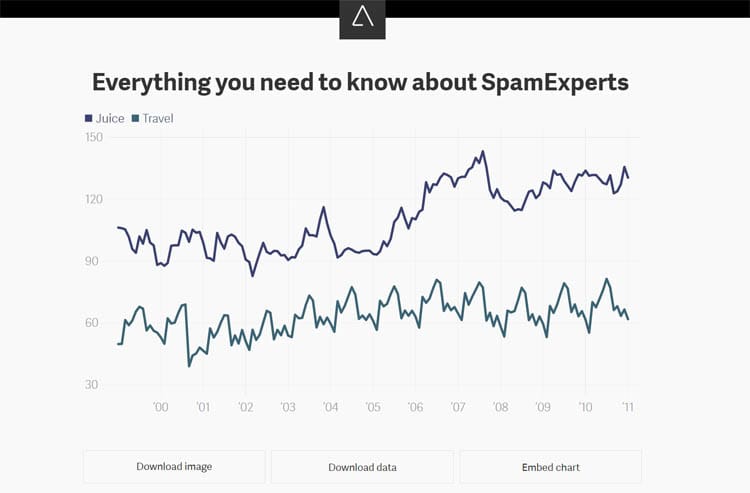
22. Canva
Perhaps one of the more user-friendly web-based graphic design tools, Canva makes for an excellent resource if you’re looking to create unique images and visualized quotes for your blog content.
Canva is free to use, and you only need to pay for added features and copyrighted images.
23. Snappa
If you’re looking for more advanced graphic design features that are still easy to maneuver for a non-pro graphic designer, then Snappa is a good choice.
For five free downloads a month, you can use Snappa to add better, personalized graphics to your blog for free.
24. Giphy
Personally, we’re not too keen on using memes in our own articles, but if you’re ok with adding memes and gifs to your content to add some fun, especially if it fits your niche, then Giphy is the free resource for you.
You can even upload images and create your own memes—for free!
Now that I think about it creating a meme about guest posters who don’t read Write for Us guidelines and complain about getting rejected seems like a good idea.
What do you think?
More Free Blog Content Ideas
25. Guest posting
Guest posting is a practice I’m sure you already know.
It’s when you submit free blog content to be published to a good website in exchange for a free dofollow/nofollow link or exposure.
So if you want a regular source of free blog content for your site, you should open up a Write For Us page, which will let bloggers know of your requirements, the topics you cover, what they’ll get in exchange, etc.
Of course, to get any interested blog contributors, you first need to have a good, non-spammy website with decent Domain Authority (DA).
The higher than 30 you go, the more guest blogging proposals you’ll get.
So make sure to build good DA and reputation for your site.
You can also proactively reach out to influencer bloggers in your target niche.
This would typically take you some time in prospecting and outreach, and we have done it before, which is why we developed NinjaOutreach to help speed things up.
Time Investment required: Moderate to Heavy (Just 1 to 2 days for reviewing contributions, but months for building your site’s DA.)
26. Crowdsourced/Expert Roundup posts
Expert roundup posts are a superb content marketing trifecta: you get to open up a dialogue with influencers in your niche, you get free blog content, and you get a highly linkable asset.
Most bloggers want to participate in expert roundup posts because doing so also gives them exposure as well as a backlink.
All they need to do is give you a few sentences of free content. An efficient quid pro quo.
To start, open an influencer prospecting tool to look for other high-performing roundup articles in your target niche and make a list of the experts who participated.
Create a survey form with your interview question and send these out to your prospects.
From our experience, a good rule of thumb is to send to at least 250 to 300 people if you want to get at least 50 responses.
The more responses you want, the higher your prospect pool should be.
Once responses start pouring in, you just curate them, add an introductory sentence or two, even a paragraph, if you’re so inclined, and voila, a whole new article for your blog, for free.
Here’s another example of how to create content from crowdsourced content.
Rand Fishkin asked people to send in their advice on how to rank a webpage in 2018 in 280 words or less.
He picked the best ones from the responses he got and turned these into a Whiteboard Friday episode about how to do SEO in 2018.
Time Investment required: Moderate to Heavy (Approx. 2 to 3 weeks)
27. Host Interviews
Instead of spending hours researching and then putting together an article, why not interview an expert in your niche? In our case, we were able to host a chat interview with Moz’s Rand Fishkin.
Instead of manually researching on the web and writing things down ourselves, we went straight to an authoritative source and asked him our burning SEO questions. And his responses? Turned to instant free blog content!
28. NewsJacking
Newsjacking is when you convert major news into an article. It’s not new, but it deserves a place on this list because so often, other bloggers forget to use this tactic.
Also, when you ride on the coattails of a trending topic, the timeliness, even controversy, that surrounds that news, could help you promote your content much faster than writing about stale topics.
For example, instead of having to manually research and put together a lengthy article about SEO, we went deep into a then-hot news topic: Google’s latest search quality evaluator guideline updates.
We opened up Google’s guidebook, summarized, and wrote concise, TLDR descriptions for their quality guidelines along with our short analyses.
Instant article!
Average Time Investment Required: Short (Approx. 2 to 4 hours)
Ultimate resource lists are easy content pieces to put together.
Like expert roundup posts, they are very linkable, and are easy to rank because of course, people like massive lists of the things they need!
Take for example our ultimate list of 200 SEO tools—it’s not easy to try everything out in one go, so it’s a page worth bookmarking and spending some time on.
How to make one? Simple. We made a list of all the top SEO tools using Google and a handy scraper.
Next, we put everything on a list and, for the descriptions, simply used any available meta descriptions of each tool. You can find those on their webpage or business pages.
If anything is grammatically incorrect or not very reader-friendly, we edit. This is significantly faster than if we’d written the 200-item list from scratch ourselves.
Average Time Investment required: Short (Approx. 4 to 6 hours)
30. Create a “Top xyz list” type post
This is much like creating an ultimate resource list except, in this case, we’re curating web pages—blogs or articles.
Take for example this list of top business blogs that we published.
Again, much like creating a resource list, we looked for the top blogs in our niche via BuzzSumo and NinjaOutreach.
We then manually whittled down our list by DA until we came to a final number.
Now instead of whipping up an article from scratch, we were able to make free content for our blog just by curating a list of our recommended business blogs and adding short descriptions for each to guide our readers.
31. Repurpose multimedia into text content
Repurposing multimedia into text content is nothing new, but it’s another item on this list precisely because of how ingenious and straightforward it is to execute.
You can just pull up trending Youtube tutorials, podcasts, and online courses.
Next, you can break these down and turn each section into outlines for your article.
For example, if you want to write about Google Adwords, you can do a search for one of the top courses online about this topic.
Check out the curriculum, and you’ve got yourself an instant article skeleton.
If you’re watching a free course or something from Youtube, you can just skip through certain parts and adjust the playback speed so you can quickly harvest the meat from each section and put those into your article.
32. Repurpose old content
Another way to get more free blog content is to analyze already published articles and split those that are too lengthy or forced into two or more pieces if those are not semantically related.
There are more ways you can go about this as well.
For example, you can also repurpose old content to create an ebook, like what CoSchedule did here : How to Repurpose Content
An infographic, which is something Neil Patel talked about here: Guide to Building Your Blog Audience
Or, you can even go the easier route by updating an old article, such as what Brian Dean suggests here: How to Get 260.7% More Organic Traffic
33. Repurpose “orphaned” content
The web is also a vast graveyard of defunct websites, and what you can do is to harvest some free blog content from these sites and publish any so-called orphaned content that you can use.
Simply do a search for websites in your niche, or you can also look at Flippa like what we did here : Buying Websites for Sale on Flippa: What You Need to Know
Once you find anything that looks good, see if you can improve it, then simply republish.
It will do little help for SEO but finding good content may help your readers, so you can hit republish and just add a “Noindex” tag to be safe.
34. Translate content into other languages
Translating your popular content into English/other languages can be almost another way to create free blog content for your site.
So check out your Google Analytics and see if you’ve got any visitors from other countries.
If you’ve got a good portion of visitors from France, for example, it would probably make some sense to translate some of your popular content into French.
Fact: we published a Spanish translation of one of our most popular articles, 500 Ways to Make Money Online.
35. Curate Content
Creating curated content is also known to generate virality.
Listicles such as “Top articles/videos/discussions/infographics/statistics/studies” you should look at today typically get a lot of engagement and traffic, from our experience.
Take for example our curated list of SEO tools and beauty blog influencers.
Even Hubspot created a dedicated page just to curate top marketing statistics.
Just look at all those referring domains on Ahrefs. There are even 11 .edu backlinks in there and one from a .gov domain.
Hubspot’s example just shows how curated data seems like an excellent way to make not only free but credible, linkable assets.
Free content curation tools
To help you gather the content that matters to you, here are some free content curation tools you can try.
Note: Not all of these tools are completely free.
Some are freemiums, where they have a premium and a free version.
The ones we included in this list are tools whose free versions are actually usable.
36. HARO
HARO is a Q&A site for journalists and writers and is something you can use to crowdsource answers for your blog content for free.
Sign up for the service and choose your category. Then send out your questions.
These will be sent out to HARO’s other subscribers, who will then choose to respond to your answer and provide you with content that you can quote and use in your article.
The “Paid” List
If you can get blog content for free, then nobody should be paying any other professional or agency for content, right?
And yet, people still pay to buy articles for their blog.
In this section, we want to show examples of paid tools and services that demonstrate why, despite the existence of free options, most credible businesses still choose to shell out cash to buy blog content.
37. Unique Article Creator
Unique article creator refers to itself as a multilingual, SEO-friendly blog content generator.
However, if you want 100% unique content, you’re going to have to pay up.
It costs $4 a month for unlimited article rewrites.
Again, the quality of these articles leave much room for improvement, so you’ll still need to edit to make them unique and readable.
38. Article Generator.org
This functions much the same way as the Article Creator, where you need to put in your keyword, and it scrapes content online that you can use.
If you have a premium key, the tool can then rewrite this content for you and make it unique.
As mentioned before, content obtained this way usually will still need a human editor to make them readable and natural.
Pop these into Grammarly and correct anything too glaring in terms of grammar, word usage, and style, and once they’re readable and plagiarism free, then you’re good to go.
This should take you at least 30 to 120 minutes.
39. ArticleForge
ArticleForge is supposed to generate unique content based on material “researched” or scraped from the web. You just type in your focus keyword and some sub-keywords, then click “Create New Article.”
You can also link other accounts such as Copyscape to ensure uniqueness and WordAI for word-spinning.
Unfortunately, even after signing up and even paying for the service, I still can’t generate a usable article from the service.
I’ll update before my subscription ends (in a month) if I can get any results.
40. Articoolo
Articoolo is a pay-per-use article generator and rewriter. If you sign up for an account, you get free credit to try out the tool.
Below, I’ll use my free credit to see if Articoolo can generate an article for me about “free blog content.”
You’ll need to set your preferences though, and the maximum word count is only up to 500 words.
While waiting, you’ll get something that looks like this:
After a minute or few, I finally got my free, auto-generated article.
If you read it, it’s actually pretty amazing. The writing is contextual, and I can say it’s the best auto-generated content I’ve seen to date.
However, it still missed the actual topic I wanted to write about.
It also talked at length about multilevel marketing, which is far off base from the topic I indicated.
If you think there’s potential, below is the price list.
41. WordAI
Next up is WordAI, an article spinner tool.
There is a free 3-day trial, and after that, you get charged $49.95 per month.
If you go over 10,000 words, you get charged an extra $2.
Below is the original text that I pasted onto the tool.
It’s the Google Maccabees update analysis on seroundtable by Barry Schwartz.
Set your preferences, then just click “Spin Now.”
After a while, I was given three options. First, the “Super Unique Spin”
And two regular spins, one of which you can see and judge below:
First off, they’re still unusable as is.
However, they’re definitely much better and easier to edit compared to the first free article spinners I listed in this article.
42. Wordsmith
In case you were disappointed by the previous content generator tools we looked at, these next ones in the list may surprise you.
There are actually much higher-tech tools that have produced near human-quality content.
These tools are able to pore through reams of data, make an analysis, and publish a narrative much faster than a team of humans can.
They are powerful, and the most expensive ones on this list.
Wordsmith is one example. It is a product of Automated Insights (AI), and is described as “a natural language generation (NLG) platform that turns data into insightful narratives.”
If you think this is all just marketing speak and, that when we actually test the tool, we’ll get the sad results we got from the previous generators we tried, then you may be wrong.
No less than the Associated Press has already used Wordsmith for their publication.
Below is an example of an article Wordsmith wrote.
Surprised?
No glaring errors there, right?
Now click here to see more AI-generated articles that will make you think twice about whether it was really written by a machine or not.
43. Quill
Quill by Narrative Science, is Wordsmith’s competitor.
Quill, like Wordsmith, is also powered by NLG and, according to its description, “transforms data into Intelligent Narratives at scale, in conversational language anyone can understand.”
So fundamentally, they work the same.
Like its competitor, Quill also has an impressive clientele of Wall Street bigwigs the likes of Credit Suisse, Deloitte, MasterCard, and PricewaterhouseCoopers.
Oh yeah, Quill even has an author account on Forbes Magazine, where you’ll see all of its AI-generated articles on sports and earnings reports.
Below is an example of what Quill wrote.
Impressive as well, right? Unfortunately, all that comes at an impressive price.
At the moment, I can’t report on how much it all costs, because these companies only have demo scheduling instead of pricing pages.
Perhaps, to leave the cost to the imagination, and to open the door only for those who dare venture close.
44. NinjaOutreach Premium Content Service
We’ve mentioned the NinjaOutreach premium content writing service before.
Compared to the other options on this list, this service is not automatically generated, and it’s not free.
It is what it is—a content writing service where you pay for a professional, human writer’s time to interview you, look at your business and website needs, research, strategize, then craft a high-quality article (or articles) that are specifically targeted to meet your goals.
Below are examples of the kind of articles you can get from the service.
This one was published on Jon Morrow’s blog, SmartBlogger.
The Quickest and Easiest Way to Create a List Post That Goes Viral
This one was published on our blog.
So You're A Marketing Manager - Here's What You Need To Know!
If you take a look and compare these with the free content examples we showed before, you’ll see the remarkable difference in quality, thoroughness, and readability.
Of course, choosing which content type and procurement method all depend on what you’ll use the content for.
Is it for something highly client-facing that will directly reflect on your business’s brand reputation?
Go for premium.
If not, then you’ve got plenty of free choices.
Everything else is up to you.
Conclusion
So now you’ve got all these options to generate free content for your blog. We’ve even gone ahead and gave you some paid examples, too!
Just remember, free blog content can work—just be careful where you use it for so you don’t get your site and your business’s brand reputation in trouble!
This article was originally written by Dave Schneider, NinjaOutreach Co-Founder and CEO. It has since been updated by Hazel Mae Pan, NinjaOutreach’s Content Manager.
The post Free Blog Content Resources [The Ultimate List] appeared first on NinjaOutreach.
source https://ninjaoutreach.com/free-blog-content/




